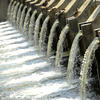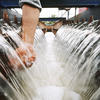You are here
History Down the Drain
11.15.2016, by
While renovating a sand filter, a water purification device located in Orléans, researchers were able to access sediments that had accumulated since 1942 from particles transported in the wastewater and rainwater network. They hope to reconstruct over 70 years of local history through their analyses.

1
Slideshow mode
Under the Quai de la Madeleine in Orléans (central France) is the sand filter that processes 7 million m³ of wastewater and rainwater produced each year in the northern part of the city.
Cyril FRESILLON/ISTO/CNRS Photo Library

2
Slideshow mode
The sand filter, a cone-shaped basin, is used to remove the densest particles found in wastewater after which the water is transferred to the town’s two wastewater treatment plants.
AgglO Orléans Val de Loire

3
Slideshow mode
During a coring operation in March 2016, the researchers cored 1.5 meters of sediment from the filter, which corresponds to accumulation between June 2015 and March 2016.
Cyril FRESILLON/ISTO/CNRS Photo Library

4
Slideshow mode
Seventeen cores have already been drilled, with the longest to date measuring 3 meters and covering the period 1980-2016. The total depth of the sediment accumulated in the sand filter is 17 meters.
Cyril FRESILLON/ISTO/CNRS Photo Library

5
Slideshow mode
From the construction of the filter in 1942 until today, a sedimentary archive was built which contains copious information about this period, evidently affected by human activities.
Cyril FRESILLON/ISTO/CNRS Photo Library

6
Slideshow mode
Inside these sedimentary cores is a compilation of the flow of organic and mineral matter resulting from such diverse “events” as heavy rain and the concentration of matter flushed down the drains in the mornings.
Cyril FRESILLON/ISTO/CNRS Photo Library

7
Slideshow mode
Once the core has been removed, the researchers cut out the section of the tube containing the sediments and then prep it for transportation to the laboratory.
Cyril FRESILLON/ISTO/CNRS Photo Library

8
Slideshow mode
On arrival at the Institut des Sciences de la Terre d’Orléans (ISTO), the sedimentary cores are stored in the core repository. This cold-room, kept at a constant 4°C, prevents deterioration of the samples that might otherwise result from such things as bacterial growth.
Cyril FRESILLON/ISTO/CNRS Photo Library

9
Slideshow mode
First operation: the sedimentary core is cut along its length into two sections. One half is stored intact for archival while the other undergoes various types of analysis.
Cyril FRESILLON/ISTO/CNRS Photo Library

10
Slideshow mode
During visual inspection, the researcher identifies areas of heterogeneous matter such as the alternation between organic and mineral matter, as seen here. She also notes the presence of elements such as this piece of broken bottle.
Cyril FRESILLON/ISTO/CNRS Photo Library

11
Slideshow mode
Using a scraper, she removes the surface sediments that are likely to have been slightly displaced when cutting the tube and which could be detrimental to the quality of the analyses.
Cyril FRESILLON/ISTO/CNRS Photo Library

12
Slideshow mode
The sediments contain both natural organic and man-made molecules that the researchers will attempt to identify and quantify.
Cyril FRESILLON/ISTO/CNRS Photo Library

13
Slideshow mode
Samples are taken from the core in order to identify molecules, also known as "molecular biomarkers," such as caffeine, nicotine, and aspirin, etc.
Cyril FRESILLON/ISTO/CNRS Photo Library

14
Slideshow mode
Following analysis, each sample will provide a snapshot of a given period concerning a varied range of areas such as transport, diet, health, energy, construction, biodiversity, industry and leisure activities.
Cyril FRESILLON/ISTO/CNRS Photo Library

15
Slideshow mode
The samples are placed in an extractor, which, much like a coffee machine (but in which solvents replace water), is able to process the sediments. It produces an extract or “juice” of the sediments that contains organic molecules.
Cyril FRESILLON/ISTO/CNRS Photo Library

16
Slideshow mode
These extracts then undergo analysis by gas chromatography and mass spectrometry to determine their molecular composition.
Cyril FRESILLON/ISTO/CNRS Photo Library

17
Slideshow mode
By comparing the data collected, the researchers will attempt to retrace the town’s "finer" history and thus observe the changes in dietary habits, intake of pharmaceutical drugs, cigarettes, as well as the use of plastics and different types of gasolines, and so on.
Cyril FRESILLON/ISTO/CNRS Photo Library
Explore more
Earth
Article
11/09/2025
Article
10/22/2025
Article
07/16/2025
Article
07/07/2025
Article
05/31/2025
Geochemistry
Article
12/06/2021
Article
05/25/2017
Wastewater
Article
09/22/2020
Article
08/07/2019
Article
05/24/2019











